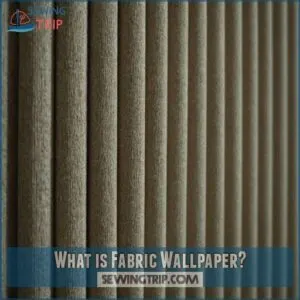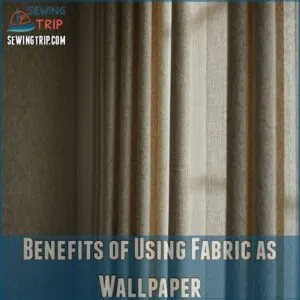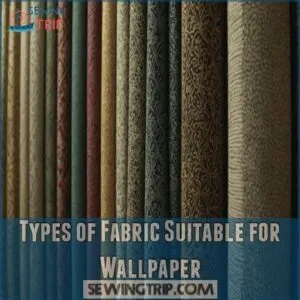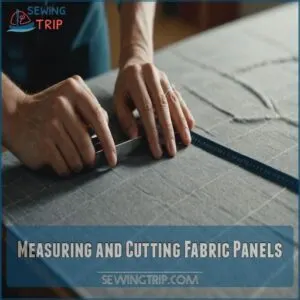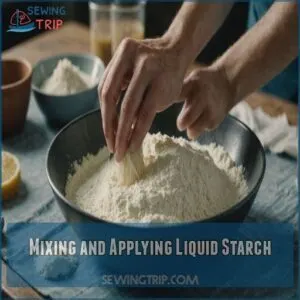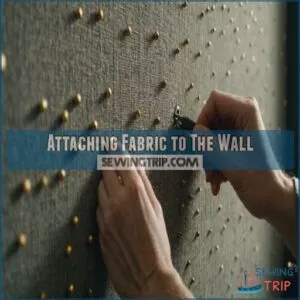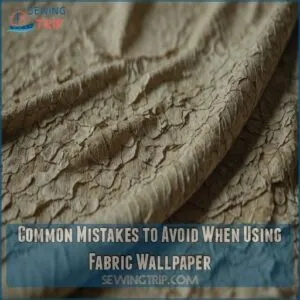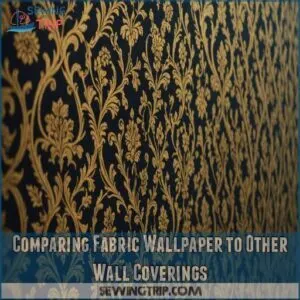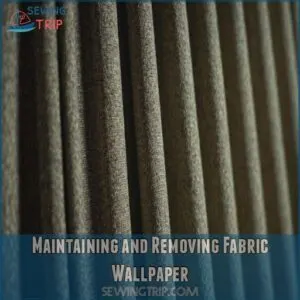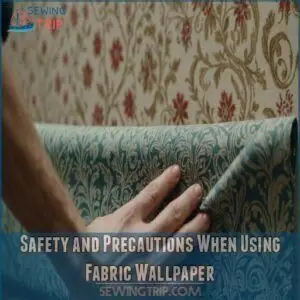This site is supported by our readers. We may earn a commission, at no cost to you, if you purchase through links.
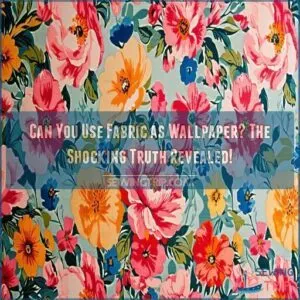
This trendy décor option lets you customize your walls without the long-term commitment.
With just some fabric and liquid starch, you can create a chic wall covering that’s easily removable—a true blessing for renters and the commitment-phobic.
Choose light fabrics like cotton or polyester, and get ready to transform your space without breaking the bank.
Say goodbye to boring walls and hello to personal flair.
Just avoid heavy fabrics or heat sources, and your walls will look fabulous!
Need more tips? Stay tuned for stylish secrets!
Table Of Contents
- Key Takeaways
- What is Fabric Wallpaper?
- Benefits of Using Fabric as Wallpaper
- Types of Fabric Suitable for Wallpaper
- How to Apply Fabric Wallpaper
- Common Mistakes to Avoid When Using Fabric Wallpaper
- Comparing Fabric Wallpaper to Other Wall Coverings
- Maintaining and Removing Fabric Wallpaper
- Design and Style Considerations
- Safety and Precautions When Using Fabric Wallpaper
- Frequently Asked Questions (FAQs)
- Conclusion
Key Takeaways
- You can easily transform walls with fabric using liquid starch, making it a renter-friendly, removable option.
- Choose light fabrics like cotton or polyester for best results, avoiding heavy materials like wool and velvet.
- Fabric wallpaper is budget-friendly and allows for easy updates without damaging walls.
- Be cautious of moisture and heat to prevent discoloration and spoilage of the fabric.
What is Fabric Wallpaper?
You’ve probably seen traditional wallpaper, but have you heard of fabric wallpaper?
It’s a DIY décor trend that lets you stick fabric panels to your walls using liquid starch, giving you a fresh look without the commitment.
Definition and Explanation
Ever dreamed of wrapping your walls in your favorite fabric?
Welcome to fabric wallpaper!
This DIY décor trend lets you transform your space using fabric panels and a simple starch adhesive.
It’s a modern twist on traditional wall coverings that’s both removable and temporary.
You’ll love how it gives you the freedom to switch up your style without breaking the bank or damaging your walls.
Ready to give your room a fabric facelift?
Brief History and Evolution
Fabric wallpaper’s journey is a tapestry of innovation.
You might be surprised to learn it’s not just a modern trend.
This DIY décor option has roots in ancient textile traditions but has evolved to meet today’s needs for flexibility and style.
If you’re looking for fabric wall art online, you can check out fabric wall art options.
Here’s a quick rundown of fabric wallpaper’s evolution:
- Origins in ancient tapestries and wall hangings
- Popularity surge during the Arts and Crafts movement
- Influence of textile wallpaper on interior design trends
- Innovations in adhesive technology making application easier
- Recent resurgence as a renter-friendly, customizable option
Benefits of Using Fabric as Wallpaper
You’ll be amazed at how fabric wallpaper can transform your space without breaking the bank.
It’s not just wallet-friendly, but also a breeze to remove and reuse.
Plus, it lets your walls breathe, keeping pesky mold at bay.
Affordability and Cost-Effectiveness
Watching your wallet? You’re in luck! Using fabric as wallpaper isn’t just a creative choice—it’s a savvy money move.
With solid fabric costing as little as $2 per 10-square-foot panel, you’ll be laughing all the way to the bank.
Compare that to pricey traditional wallpaper, and you’ll see why DIY enthusiasts are jumping on this trend.
Plus, you can snag some seriously stylish looks without breaking the bank.
Talk about value for money!
Easy Removability and Reusability
Ready for a game-changer in temporary decor?
Fabric wallpaper isn’t just easy on your wallet—it’s a renter’s dream come true.
You’ll love how simple it’s to peel off when you’re ready for a change.
Just dampen a sponge, and voila!
Your walls are back to square one, no damage done.
Plus, you can store that fabric and reuse it for future craft projects, such as creating custom-fit garments with the help of sewing patterns guides.
Talk about a win-win for your walls and your creativity!
Breathability and Mold Resistance
Let’s talk about a hidden superpower of fabric wallpaper: its ability to breathe!
Unlike traditional wallpapers that trap moisture, fabric allows your walls to exhale.
This natural ventilation is like a built-in dehumidifier, keeping mold at bay.
You’ll love how it maintains healthy air circulation, making your space feel fresher.
Plus, it’s a breeze to install and remove, giving you the freedom to switch up your style whenever the mood strikes!
Types of Fabric Suitable for Wallpaper
You’ll be amazed at how many fabrics can transform your walls into stunning masterpieces.
From lightweight cotton that’s a breeze to work with, to luxurious silk that’ll make you feel like royalty (but might test your patience), choosing the right fabric is key to your DIY wallpaper success.
Lightweight Fabrics Like Cotton and Polyester
For fabric as wallpaper, lightweight is the way to go.
You can find various textile wallpaper products like those at Textile Wallpaper Options.
Cotton and polyester are your DIY dream team.
These fabrics are easy to handle, stick well, and won’t sag like heavier options.
Plus, they’re budget-friendly and come in a rainbow of colors and patterns.
You’ll have a blast matching your decor and expressing your style.
Just remember, smooth application is key for that picture-perfect finish!
Heavy Fabrics to Avoid Like Wool and Velvet
While lightweight fabrics are your go-to, heavy hitters like wool and velvet are trouble in paradise.
They’re like uninvited party guests who overstay their welcome.
These bulky beauties might look tempting, but they’ll sag faster than your motivation on a Monday morning.
Imagine wrestling with a velvet curtain on your wall – not pretty!
Stick to lighter options for a hassle-free, gravity-defying fabric wallpaper experience.
Silk Fabric as a Popular but Challenging Option
Countless homeowners dream of silk fabric wallpaper‘s luxurious sheen, but you’ll need deep pockets for this beauty.
A single silk panel can set you back more than standard wallpaper alternatives.
To truly appreciate its unique qualities, you need to understand what silk feels like, featuring a smooth, soft, sensuous texture against the skin, as seen in silk’s tactile properties.
You’re also in for a tricky installation process – silk’s delicate nature means even pros sometimes shy away from handling it.
Still, if you’ve got the budget and patience, silk’s timeless elegance can transform your space dramatically.
How to Apply Fabric Wallpaper
You’ll be amazed at how simple it’s to transform your walls with fabric using just a few basic supplies and some liquid starch.
Whether you’re a DIY newbie or a seasoned decorator, you’ll find that applying fabric wallpaper is as easy as smoothing out a wrinkled shirt (and way more fun).
Measuring and Cutting Fabric Panels
Many DIY enthusiasts find measuring and cutting fabric panels to be a real head-scratcher, especially when choosing the right cutting tools, like quality fabric scissors, but you’ll nail it with the right tools.
Grab your measuring tape and drop cloth first. Measure your wall’s height, adding two extra inches for wiggle room.
Follow the fabric’s grain when cutting panels with sharp fabric scissors, and don’t forget to pattern-match adjacent pieces.
Keep your x-acto knife handy for precise trimming around outlets.
Mixing and Applying Liquid Starch
Now that you’ve got your perfectly measured panels, let’s cook up some magic with liquid starch, which is a common DIY fabric stiffener.
Start by mixing equal parts liquid starch and water in your bucket, think of making a smoothie for your walls. You’ll want the consistency of heavy cream.
Pour the mixture into a paint tray, and get your roller ready for action. Don’t skimp on saturation levels!
Attaching Fabric to The Wall
Ready to put your fabric masterpiece on the wall?
Let’s transform that starchy mixture into wall-worthy.
Getting your fabric up isn’t rocket science, but you’ll want to follow these proven steps for picture-perfect results, which you can find the perfect materials for on the fabric wallpaper market at places like Everysimply Fabric.
Start at the top corner, smoothing as you go to banish those pesky air bubbles.
Keep your panels level using a trusty laser level.
Work in sections, applying even pressure with a squeegee.
Trim excess fabric with a sharp utility knife for clean edges.
Common Mistakes to Avoid When Using Fabric Wallpaper
You’ll want to watch out for those sneaky fabric wallpaper mishaps that can turn your DIY dreams into decor disasters.
Whether it’s choosing the wrong fabric type or installing it in moisture-prone areas, knowing what not to do will save you from those facepalm moments we’ve all had with home projects.
Discoloration From Heat and Moisture
Let’s talk about the sneaky culprits that can turn your gorgeous fabric wallpaper into a not-so-pretty sight.
You’ll want to keep your fabric panels away from heat sources – those hairdryers and radiators can team up with the baking soda in your starch solution to create unwanted yellow spots.
Think of it like leaving a white t-shirt too close to a heater – not the look you’re going for!
Damage From Exposure to Water
While heat can cause discoloration, water’s your fabric wallpaper’s worst enemy.
Think twice before installing it in your bathroom or kitchen – one splash, and you’ll watch your beautiful design dissolve faster than a sugar cube in hot coffee.
You’ll want to keep spray bottles at arm’s length during cleaning, and don’t forget those sneaky water spots near windows and air conditioners that can turn your decor disaster into a soggy mess.
Choosing The Wrong Type of Fabric
Now that you know water can wreak havoc on your fabric wallpaper, picking the right material becomes your next superpower.
You wouldn’t wear a wool sweater to the beach, right?
The same logic applies to your walls.
Here are four fabric no-nos that’ll save you from a DIY disaster:
- Heavy fabrics that sag like yesterday’s jeans
- Stretchy materials that’ll shrink faster than your favorite shirt
- Non-stain resistant fabrics that’ll show every fingerprint
- Textured materials that’ll collect dust like a magnet
Comparing Fabric Wallpaper to Other Wall Coverings
You’re in for a treat as we explore how fabric wallpaper stacks up against its wall-covering cousins.
Get ready to uncover the perks and quirks of this DIY darling compared to traditional and temporary options – it’s time to see which one will steal the spotlight in your home makeover!
Traditional Wallpaper and Its Limitations
Ever wondered why traditional wallpaper can be such a pain?
It’s like committing to a tattoo for your walls.
Sure, it’s durable, but it comes at a cost – both to your wallet and your sanity.
The application process is a nightmare, requiring special tools and buckets of messy paste.
And when you’re ready for a change? Good luck removing it without damaging your walls or losing your mind!
Temporary Wallpaper and Its Advantages
Temporary wallpaper is shaking up the DIY home makeover scene!
Unlike its stubborn cousin, it’s a breeze to remove when you’re ready for a change. You’ll love how it lets you experiment with wallpaper trends without committing long-term.
It’s perfect for renters seeking stylish, rent-friendly decor options. Plus, it’s a great eco-friendly choice that won’t damage your walls.
Ready to give your space a quick facelift? Temporary wallpaper’s got your back!
When to Choose Fabric Wallpaper Over Others
Fabric wallpaper shines when you’re craving texture and personality in your space.
It’s perfect for rental decor or nursery design, letting you switch up your style without commitment.
In small spaces, it adds depth without overwhelming.
Plus, it’s eco-friendly and budget-conscious. You’ll love how it transforms a room, giving you control over your environment.
It’s like dressing your walls in their favorite outfit!
Maintaining and Removing Fabric Wallpaper
You’ve decked out your walls with fabric, and now it’s time to keep them looking fresh.
Learn how to your DIY masterpiece and remove it when you’re ready for a change, without breaking a sweat or your walls.
Tips for Keeping Fabric Wallpaper Clean
Your fabric wallpaper’s no pushover.
For a sparkling clean look, grab a soft brush attachment and vacuum gently. Spot-clean stains with a damp cloth and mild soap.
Control humidity to prevent mold growth.
Refresh your walls with a fabric-safe spray. Remember, a little TLC goes a long way in keeping your unique decor fresh and fabulous.
Fabric care 101: regular maintenance is key!
How to Remove Fabric Wallpaper Without Damage
Ready to say goodbye to your fabric wallpaper? Let’s peel back the layers without breaking a sweat—or your walls!
Grab a spray bottle filled with warm water and give your wall a gentle mist. As the starch loosens its grip, you’ll be able to lift the fabric off like you’re revealing a masterpiece.
For stubborn spots, a little extra spritz and patience go a long way. Your walls will thank you for this gentle sendoff!
Reusing and Repurposing Old Fabric Wallpaper
You’ve got your old fabric wallpaper off the wall – now what? Don’t toss it just yet! Your DIY spirit can breathe new life into that textile.
Here’s how to transform your old wall decor into fresh home accents:
- Create funky throw pillows for an instant room refresh
- Fashion unique lamp shades for a cozy ambiance
- Craft stylish placemats or table runners for dining flair
- Make eye-catching wall art by framing fabric pieces
These fabric upcycling ideas turn yesterday’s wallpaper into today’s chic decor, and you can also upcycle old fabrics for projects like transforming old jeans into trendy accessories. These fabric upcycling ideas turn yesterday’s wallpaper into today’s chic decor!
Design and Style Considerations
You’ve got the fabric, you’ve got the starch, but now comes the fun part: turning your walls into a canvas for your creative vision.
Let’s explore how to choose patterns, mix fabrics, and create a look that’s uniquely you – because life’s too short for boring walls.
Choosing The Right Pattern and Color
How do you pick the perfect pattern and color for your fabric wallpaper. Understanding the correct fabric type and weight for a specific project, such as choosing the right fabric, is crucial for ensuring the desired look and durability of your fabric wallpaper? It’s all about balancing your personal style with your room’s vibe.
Let’s break it down:
| Consideration | Tips |
|---|---|
| Color Scheme Inspiration | Nature, favorite art, or existing decor |
| Pattern Size | Large for drama, small for subtlety |
| Room Lighting | Bright rooms can handle bold colors |
| Accent Wall Ideas | Use statement patterns on one wall |
| Personal Style Expression | Choose patterns that reflect your personality |
Remember, your walls are your canvas. Express yourself!
Mixing and Matching Different Fabrics
Why stick to just one fabric when you can create a tapestry of textures? Mix things up by pairing bold patterns with subtle solids.
Try blending floral prints with geometric designs for a striking contrast.
Layer different textures like silk, linen, and cotton to add depth.
Don’t shy away from pattern clashing – it’s all about finding that sweet spot between cohesion and chaos.
Remember, your walls are your canvas, so let your creativity run wild!
Creating a Unique and Personalized Look
Let your walls do the talking with fabric wallpaper!
Mix unique textures and patterns to create a one-of-a-kind look, considering factors like fabric type recommendations.
Blend bold florals with subtle stripes or go wild with custom colors.
Add wall decals for an extra pop or create focal points with statement fabrics.
It’s like giving your room a fashion makeover – dress those walls in their Sunday best and watch your space come alive!
Safety and Precautions When Using Fabric Wallpaper
You’ve picked out the perfect fabric for your walls, but hold up—safety first!
Before you transform your space, let’s chat about some key precautions that’ll keep your DIY dream from turning into a decorating disaster.
Avoiding Fire Hazards and Flammable Materials
With fabric wallpaper, you’re not just decorating—you’re playing it safe.
Opt for fire-resistant fabrics to keep your walls from becoming a tinderbox.
Consider choosing fabrics with great durability and water resistance like those used for outdoor gear breathable outdoor fabrics.
Ditch the flammable starch and treat your fabric with fire-retardant sprays.
It’s like giving your walls a superhero cape!
Check local fire codes before you start, and avoid placing fabric near heat sources.
Remember, a stylish room isn’t worth risking a fiery disaster.
Safety first, fashion second!
Preventing Allergic Reactions and Skin Irritation
Sensitive souls, listen up! Your fabric wallpaper dreams needn’t be a nightmare.
Opt for hypoallergenic fabrics to dodge those pesky reactions.
Before diving in, do a small skin test to make sure you’re not barking up the wrong tree.
If starch makes you itch, try natural alternatives like cornstarch paste.
Remember, your walls should be a comfort zone, not a rash-inducing battlefield.
Play it safe, and you’ll be sitting pretty in no time!
Ensuring Proper Ventilation and Air Quality
After addressing allergy concerns, don’t forget about air quality!
Your fabric wallpaper needs to breathe.
Install a ventilation system to keep air flowing and prevent mold.
Use air filtration to trap dust and allergens.
Control humidity levels with a dehumidifier.
Bonus tip: add some indoor plants to naturally purify the air.
It’s like giving your walls a fresh start!
Frequently Asked Questions (FAQs)
Can you put Fabric on a wall instead of wallpaper?
Imagine transforming your space with vibrant fabric instead of wallpaper.
You can attach fabric with liquid starch, making it removable, budget-friendly, and stylish.
It’s like giving your room a cozy, personal touch without the permanence.
What is fabric wallpaper?
Fabric wallpaper’s a cool DIY project that lets you jazz up your walls with fabric panels using liquid starch instead of traditional adhesives, which, unlike 75% of fabric glues not washable, is a safer choice for wall decor. Fabric wallpaper’s a cool DIY project that lets you jazz up your walls with fabric panels using liquid starch instead of.
It’s affordable, removable, and ideal for renters or those who love changing decor often!
Is fabric wallpaper a good idea?
You can also use fabric to make stylish sewing machine covers, like the ones available on sewing machine covers. You’re looking at a fun, DIY option with fabric wallpaper.
It’s inexpensive and temporary, making it perfect for renters.
Just watch out for moisture and heat spots.
Plus, removing it won’t leave a trace!
Can you put Fabric on walls?
Absolutely, you can put fabric on walls using liquid starch for a unique, removable décor touch.
It’s lightweight and easy to apply, providing a quick way to transform your space.
Perfect for renters looking to personalize.
Is fabric wallpaper safe for childrens rooms?
It’s generally safe, but choose breathable fabrics like cotton. Avoid anything that might attract allergens. Always prioritize non-toxic liquid starch for a kid-friendly finish. Have fun decorating!
Can fabric wallpaper be used on textured walls?
Sure, you can use fabric wallpaper on textured walls, but expect a bit more challenge.
The bumps may prevent a smooth finish, but with extra effort and patience, you can often achieve a charming, rustic look.
How long does fabric wallpaper last?
With proper care, fabric wallpaper can last several years, but it depends on the environment and how often you switch designs.
Keep it away from moisture and heat for longer life, like keeping candy from toddlers!
What is the best adhesive alternative to starch?
Grab a can of spray adhesive for a sturdy alternative to starch.
It sticks fabric tightly, is easy to apply, and dries clear.
Just remember, ventilate the room—nobody wants a glue-sniffing adventure!
Can fabric wallpaper be used outdoors?
Ever wonder if fabric wallpaper can brave the great outdoors?
It can’t.
Weather and moisture quickly ruin it, making it unsuitable for outside use.
Indoors, it shines with charm and flexibility, bringing spaces to life painlessly.
Conclusion
Transforming your walls with fabric is as liberating as swapping flip-flops for a new pair of kicks.
If you’re wondering, "Can you use fabric as wallpaper?" the answer is yes.
It’s affordable, customizable, and great for renters.
Choose light fabrics like cotton for easy application and avoid heavy ones like wool.
With simple tools and a bit of creativity, your space can feel personalized and fresh without long-term commitment.
Give it a try and embrace your inner decorator!

